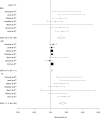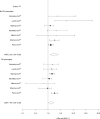MC1R variants as melanoma risk factors independent of at-risk phenotypic characteristics: a pooled analysis from the M-SKIP project
- PMID: 29795986
- PMCID: PMC5958947
- DOI: 10.2147/CMAR.S155283
MC1R variants as melanoma risk factors independent of at-risk phenotypic characteristics: a pooled analysis from the M-SKIP project
Abstract
Purpose: Melanoma represents an important public health problem, due to its high case-fatality rate. Identification of individuals at high risk would be of major interest to improve early diagnosis and ultimately survival. The aim of this study was to evaluate whether MC1R variants predicted melanoma risk independently of at-risk phenotypic characteristics.
Materials and methods: Data were collected within an international collaboration - the M-SKIP project. The present pooled analysis included data on 3,830 single, primary, sporadic, cutaneous melanoma cases and 2,619 controls from seven previously published case-control studies. All the studies had information on MC1R gene variants by sequencing analysis and on hair color, skin phototype, and freckles, ie, the phenotypic characteristics used to define the red hair phenotype.
Results: The presence of any MC1R variant was associated with melanoma risk independently of phenotypic characteristics (OR 1.60; 95% CI 1.36-1.88). Inclusion of MC1R variants in a risk prediction model increased melanoma predictive accuracy (area under the receiver-operating characteristic curve) by 0.7% over a base clinical model (P=0.002), and 24% of participants were better assessed (net reclassification index 95% CI 20%-30%). Subgroup analysis suggested a possibly stronger role of MC1R in melanoma prediction for participants without the red hair phenotype (net reclassification index: 28%) compared to paler skinned participants (15%).
Conclusion: The authors suggest that measuring the MC1R genotype might result in a benefit for melanoma prediction. The results could be a valid starting point to guide the development of scientific protocols assessing melanoma risk prediction tools incorporating the MC1R genotype.
Keywords: cutaneous melanoma; genetic epidemiology; melanocortin 1 receptor; pigmentation; pooled analysis.
Conflict of interest statement
Disclosure The authors report no conflicts of interest in this work.
Figures



References
-
- Erdmann F, Lortet-Tieulent J, Schuz J, et al. International trends in the incidence of malignant melanoma 1953–2008: are recent generations at higher or lower risk? Int J Cancer. 2013;132(2):385–400. - PubMed
-
- Wernli KJ, Henrikson NB, Morrison CC, Nguyen M, Pocobelli G, Blasi PR. Screening for skin cancer in adults: updated evidence report and systematic review for the US Preventive Services Task Force. JAMA. 2016;316(4):436–447. - PubMed
-
- Gandini S, Sera F, Cattaruzza MS, et al. Meta-analysis of risk factors for cutaneous melanoma – I: common and atypical naevi. Eur J Cancer. 2005;41(1):28–44. - PubMed
-
- Gandini S, Sera F, Cattaruzza MS, et al. Meta-analysis of risk factors for cutaneous melanoma – II: sun exposure. Eur J Cancer. 2005;41(1):45–60. - PubMed
-
- Gandini S, Sera F, Cattaruzza MS, et al. Meta-analysis of risk factors for cutaneous melanoma – III: family history, actinic damage and phenotypic factors. Eur J Cancer. 2005;41(14):2040–2059. - PubMed
Grants and funding
LinkOut - more resources
Full Text Sources
Other Literature Sources

